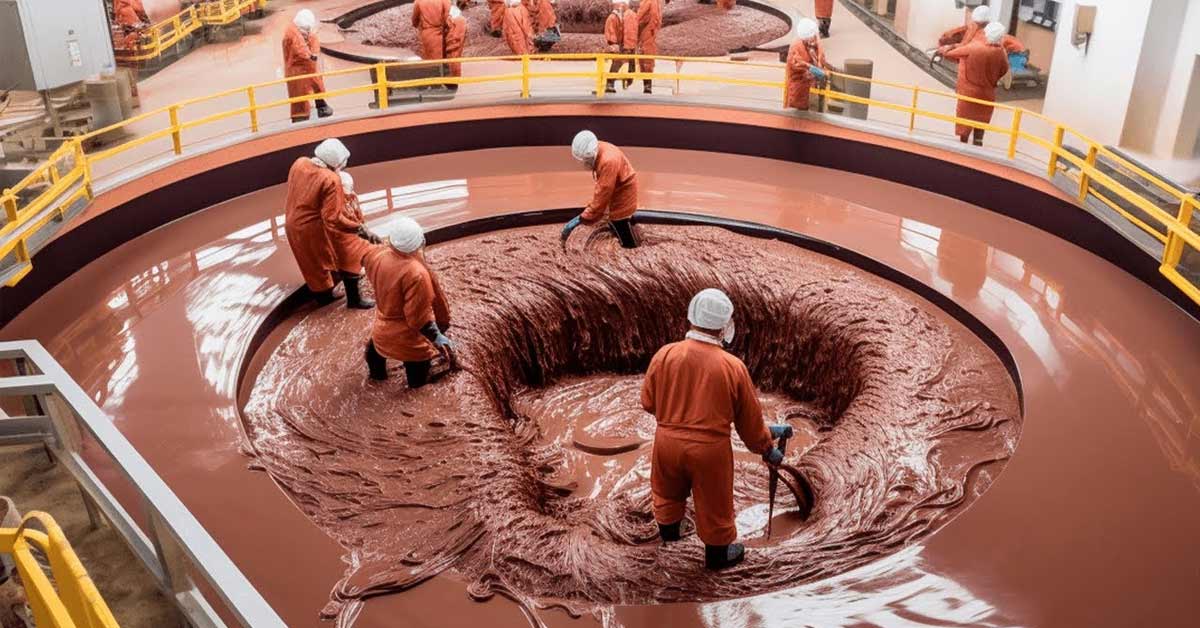ⓘ The following article is an independent and original research work of one of the authors of LAFFAZ Media. The text is paraphrased using an AI tool for brevity.
In the world of confectionery delights, chocolate stands as an undisputed champion, tantalizing taste buds with its rich, velvety allure. Imagine the satisfying snap of a chocolate bar, the smooth melt on your tongue, and the deep, comforting flavors that seem to capture the essence of indulgence itself. But have you ever wondered how this heavenly treat transforms from a humble cocoa bean to the beautifully wrapped bar you savor?
People have been eating chocolate from as early as 1750 BC. In fact, ancient humans were so fond of chocolate that they used it as a medicine and even in religious rituals. Today, this delicacy is available everywhere on the planet, with numerous brands shipping out as much as 3 million tons of it every year.
The story of chocolate starts with the Theobroma cacao tree, native to the equatorial regions once home to the ancient Mayans (Maya Civilization). These early civilizations didn’t just stumble upon chocolate; their geographic location made it possible. Cacao trees need very specific conditions to thrive: temperatures around 25°C and humidity levels above 80% — a climate found only in select regions along the Earth’s equator.
So that was the history of chocolate at a glance. Now, without further ado, I would like to take you through the fascinating process of chocolate making.
1. Harvesting the Cocoa Beans: The Boring Part
The story of chocolate begins in tropical regions close to the equator, where cacao trees flourish under the canopy of the rainforest. These trees produce large, colorful pods filled with cacao beans. Farmers carefully harvest the ripe pods by hand, using machetes to cut them from the tree.
Despite advancements in agriculture, harvesting cacao remains a manual labor-intensive process, just as it was during the time of the Mayans. Cacao pods don’t fall off the trees on their own. Workers cut them off one by one, a physically demanding process. The beans inside the pods are also extracted manually, coated in a sticky white pulp that doesn’t resemble chocolate at all — yet.
2. Fermentation: Where the Magic Begins
Once harvested, the beans and their surrounding pulp are placed in shallow containers or covered with banana leaves to ferment for 3 to 9 days.. This fermentation process is crucial as it it removes the pulp, kills bacteria, and most importantly, starts the transformation of the beans’ color and flavor — from pale to that rich chocolate brown we all know and love.
3. Drying: Sunlight as Nature’s Preserver
After fermentation, the beans are spread out under the sun to dry. This drying process, which can take up to a week, reduces the moisture content of the beans and further concentrates their flavors. The beans are turned regularly to ensure even drying.
4. Quality Inspection: Only the Best Make It
Upon arrival, the beans undergo quality checks. Inspectors cut them open to ensure they have the right color and texture. Only the best beans move forward to the roasting phase.
5. Roasting: Flavor in the Fire
The beans are first roasted on screens and then in rotating cylinders with heated air for 30 minutes to 2 hours. Roasting times and temperatures vary depending on the desired flavor profile. This step requires precision, as it can significantly influence the final taste of the chocolate. Roasting reduces moisture from 7% to 1% and causes a browning reaction involving over 300 different chemicals, which builds the deep, rich flavor of chocolate.
6. Cracking and Winnowing: Separating the Good Stuff
Post-roasting, the beans are cracked open to separate the nibs from the husks. The nibs are the edible part of the bean, rich in cocoa butter and flavor. Winnowing, a process involving the use of air currents, helps to remove the lighter husk pieces from the heavier nibs. A machine called a winnower does this job.
7. Grinding: Turning Nibs into Chocolate Liquor
The nibs are then ground into a thick, dark paste. This paste, called chocolate liquor, smells surprisingly like alcohol due to the chemical reactions involved.
If the goal is to make cocoa powder, this liquor is treated with an alkaline solution, darkening its color, reducing bitterness, and making it easier to mix.
8. Pressing: Cocoa Butter vs. Cocoa Powder
Next, the chocolate liquor is defatted. The cocoa butter is extracted, leaving behind a solid called press cake. This cake is then crushed and sifted to produce the cocoa powder used in baking and drinks.
9. Conching: Crafting Smooth Chocolate
To make actual chocolate, the extracted cocoa butter is mixed back with chocolate liquor in a process called conching. Here, other ingredients like milk powder, sugar, and vanilla are added — a technique popularized by Swiss chocolatier Daniel Peter in 1875 when he created milk chocolate using Nestlé’s powdered milk.
10. Tempering: That Iconic Snap
Tempering is a delicate process of heating and cooling the chocolate mass to specific temperatures, ensuring that the cocoa butter crystallizes properly. This step is vital for achieving the glossy finish and satisfying snap of high-quality chocolate.
11. Molding and Cooling
The tempered chocolate is poured into molds and allowed to cool and solidify. This stage can involve various creative shapes and designs, from simple bars to intricate figurines. Once solidified, the chocolate is removed from the molds and prepared for packaging.
12. Packaging
Finally, the chocolate is wrapped in protective packaging to preserve its flavor and texture. The packaging also plays a role in the marketing and presentation, often adorned with attractive designs and informative labels.
Conclusion: A Global Love Affair
From the lush cacao plantations to the meticulous craftsmanship in processing, the journey of chocolate is a blend of tradition, innovation, and passion. Each bite of chocolate carries with it a rich history and a complex transformation that brings joy to millions around the world. So, next time you indulge in a piece of chocolate, take a moment to appreciate the remarkable process that transforms simple beans into a universally beloved treat.
ⓘ As part of our ongoing support for startups and SMEs, LAFFAZ Media publishes feature and resource articles that may include references and links to external websites. These inclusions are selected at our editorial discretion to provide valuable information to our readers. LAFFAZ Media does not control, endorse, or assume responsibility for the content or practices of external websites. For more details, please refer to our Terms and Conditions.






